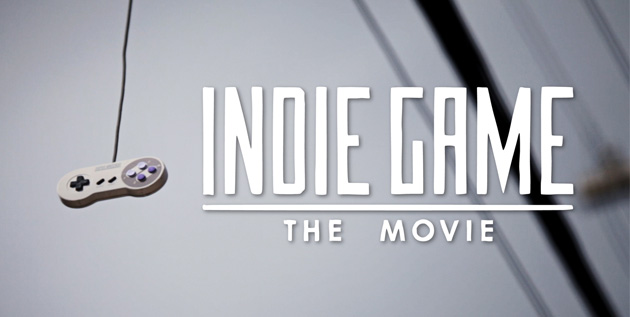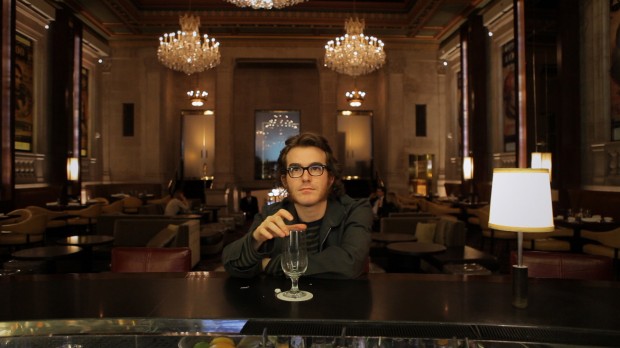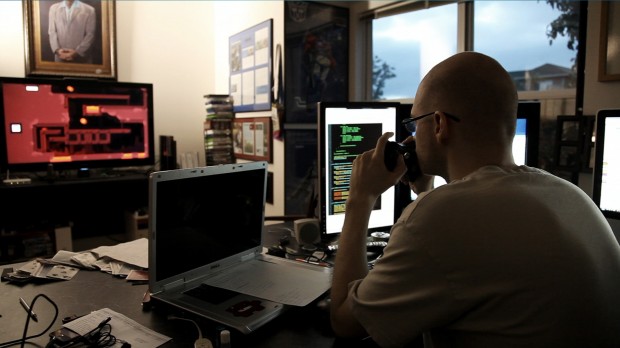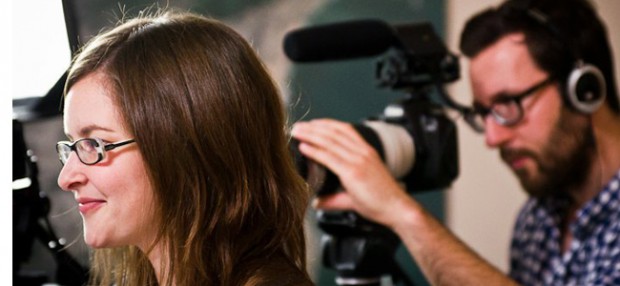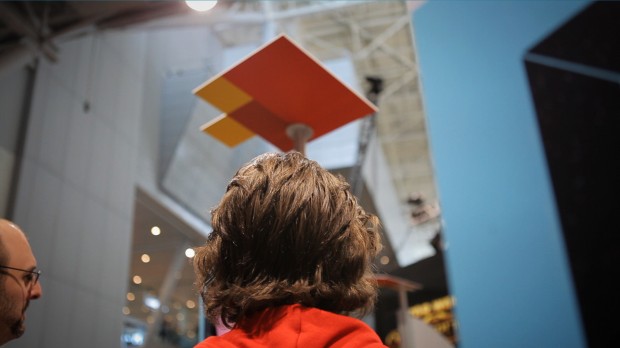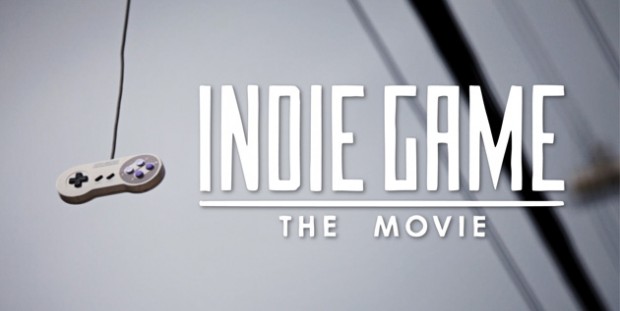One of the films that jumped out early on at the festival was Indie Game: The Movie, a Kickstarter-funded documentary about independent video game developers. The struggle of these passionate young creative minds to imbue their games with real meaning and symbolism while balancing out the entertainment factor and gameplay is reminiscent of the struggle off all independent artists.
I was lucky enough to sit down with the dynamic duo, Lisanne Pajot and James Swirsky, responsible for bringing the story of these developers with creative filmmaking technique. They offer up some good advice for anyone planning to crowd fund, discuss the possibility of the movie becoming an HBO and how independent games are closer to in relation to independent film than you may have thought. Check out the interview below and my review here.
The Film Stage: Where did the idea to make a documentary about indie game developers come about?
Lisanne Pajot: We sort of knew that indie games existed but not really. And it wasn’t until we did this short doc on Alec Holowka who created Aquaria…
James Swirsky: With Derek Yu.
Pajot: They won the big prize at the Independent Games Festival, which is kind of like the Sundance of games. And they won the big prize and we did this story about him and it was just so cool because we found out about this world and we found out about the process to make games and to be honest we hadn’t really thought about the fact that one or two man teams can make games and say something different with them. Through Alec we sort of ended up meeting a bunch of game developers. We ended up doing a job at the Game Developers Conference in San Francisco and IGS, the Independent Game Summit, and we just saw this whole room of similar people with similar stories of making games that were different.
They were interesting and looked amazing and they were reaching millions of people online. It felt like there was this sort of thing happening. There was this energy in the room and everybody was sharing and when they were sharing they were sharing about their games but really they were sharing about themselves. That whole idea of the game as an extension of personal expression was something that was interesting to us and something that we hadn’t really thought about. That’s sort of what kicked it off.
Swirsky: The stories behind the games were inspiring and heart-breaking, all at the same time.
Pajot: Like working hard and not being able to finish.
Swirsky: Yeah. Because there’s no guarantee that an indie game is going to find an audience and become a success. That’s not why you make the game. But now that it’s all set in this world of online distribution, the right game at the right time speaking to the right people can find an audience and create a millionaire overnight, basically.
Pajot: Which is a weird thing. And then we met people like Ron Carmel of World of Goo and John and all of them, and we talked to them about their sort of overnight success and it wasn’t really overnight.
Swirsky: Not at all.
Pajot: And that’s what you see in the film. The perception is that it’s overnight, but these guys have been making games for 10 years, 20 years. It’s just no one was noticing. And now they are.
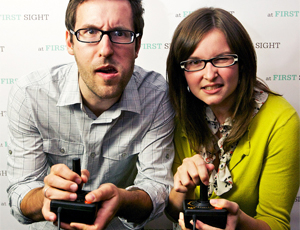 It’s kind of like how you guys made your film, too. You guys put a lot of work in and with online distribution you’re able to crowdsource and reach an audience directly through this.
It’s kind of like how you guys made your film, too. You guys put a lot of work in and with online distribution you’re able to crowdsource and reach an audience directly through this.
Swirsky: Totally. That was really important to us and that’s actually one of the things – we stole a lot from indie games. We treated the production of this movie like the production of an indie game. We announced it and were very open, even before we started, and kind of got an audience and started having the dialogue with them. And that’s kind of like our open beta period. So it created this iterative process where we’re putting out a lot of stuff…
Pajot: Content.
Swirsky: Yeah. Then we get feedback and validation and it shows that we’re on the right track and people like it. So now it’s coming time for the release at some point soon and we have like four, five, six thousand people that have invested in the movie in some way. Not all of them but like 4,000 people per-ordered the movie. But all of these people know about the movie and have been following it and have kind of grown with it. And feel invested. It’s just really unique.
Pajot: It’s an incredible feeling to think that people feel that they own it. It’s scary and stressful, but it’s also awesome. Like, awesome. In the most real sense of the word. That there’s all these people that care so much.
How did you guys decide on following specifically Jonathan Blow and Tommy [Refenes] from Super Meat Boy and Phil Fish? Were there other developers you were considering? I know there are other developers in the film popping up here and there. How’d you settle on those three?
Pajot: We actually shot with about 25 developers and we shot stories with them and through that process timing sort of worked out that we were able to follow Super Meat Boy and Fez, going towards these big goals. Release and showing the game at the gaming expo. And those things just sort of worked out as we got to know them and as we got to know them we sort of felt compelled to film with them. They’re very expressive. They’re charismatic and their games are interesting. Their games are very important to them and they’re very passionate about it. And they were going through a lot. So their stories became so much bigger that they took up more of the film than all the other developers.
Swirsky: Just to do it justice we had to start making room. It just demanded more room in the film, those stories. And we had to do some really, really hard cuts.
Pajot: There was a lot of arguing.
Swirsky: Oh, tons. We were kicking and screaming with each cut. Like each person that we removed from the film. We thought we could do it all. I think we knew on some level that we couldn’t do it all.
Pajot: But we tried.
Swirsky: But we tried. It was really hard to make those cuts but it couldn’t be a three and a half hour movie. It needed to be under 90 minutes.
Pajot: We have a special edition where all those people are going and all their stories. We’ve cut about half of it.
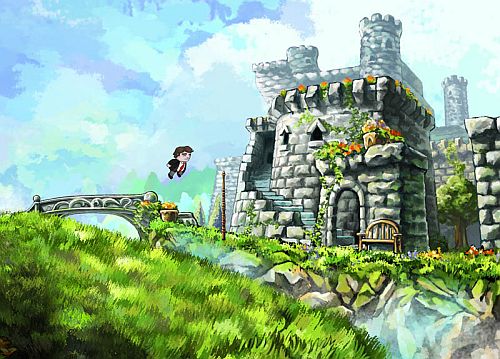 I saw an article on Kotaku talking about how HBO was considering doing this as a TV series. Is that something you guys could talk about a little?
I saw an article on Kotaku talking about how HBO was considering doing this as a TV series. Is that something you guys could talk about a little?
Pajot: Yeah. Scott Rudin and HBO have optioned Indie Game: The Movie. The premise, the idea of it, to potentially make a TV series. It’ll be a half-hour series and that’s the idea. There’s lots of things that need to line up for it to happen, but it’s so exciting because Scott Rudin, is Scott Rudin.
Right.
Pajot: We weren’t thinking about it at all. They came to us based on the trailer and then we started talking more and he just makes things that are so complex and interesting, some of the best films in the past five years.
Swirsky: He has amazing taste. You go through the IMDb and it’s just like, ‘Oh my God, I love all of these films.’ They’re so well done and tasteful. And then, I’ve never seen an HBO series that I didn’t like. That’s the absolute perfect team to make something in this world. We couldn’t be happier to be a part of it.
Pajot: Yeah, that’s just the start. It’s just the world of indie games.
Because it is blossoming. And there’s so much going on.
Pajot: There’s so many things going on. And it’s not necessarily the film. The film is sort of a jumping off point, but it will be completely fictional and we’ll see what happens with it. Hopefully it’ll happen. It works out better for us if it happens. We get to work on it, so…
I would love to watch it. So, there you go. Can you talk about the crowd funding? The process through Kickstarter? The benefits versus the cons. How challenging was it? And do you have any real good advice to give filmmakers or other people interested in using Kickstarter to help kickstart their project?
Pajot: Yeah. I think Kickstarter is awesome. If someone’s approaching the crowdfunding and I think what worked with this film was we knew who our audience was before we started. We knew who cared about it. We knew that. And I think that’s what’s important going into this and our project was a reflection of that. I think it’s a bit harder when you are approaching Kickstarter where you don’t know who you are speaking to. I think that’s one of the benefits that we had.
Swirsky: Because nobody is kind of surfing the internet and looking for a place to donate their money. Kickstarter’s just kind of a tool. It’s a tool and a facilitator of you being able to talk with your audience and access them in certain, different kind of ways. So you kind of have to realize that from the advice standpoint. Another good piece of advice: Make sure that you show something that shows and proves that you can do what you want to do. So, make sure that in that pitch it makes sense. So that people can confidently give you $15 dollars or $50 dollars or whatever.
Pajot: A lot of people would do a pitch video and we felt that we really just want to show this community and this world that we can do it. We’re capable. And this is just a slice of what we can do. That’s what that first piece was back in May 2010. That whole thing changed our lives. Within those two days, people funded our film in 48 hours with the money that we needed at the time. And our phones were buzzing. It was just this wealth of feedback, people were passing around the clip. It was just an incredible, creative feeling like, ‘Wow, people like it.’ It was just huge for us.
Swirsky: Yeah, and Kickstarter’s great for getting the money that you need, and that’s very important, but it’s also really great because at the end of these campaigns we had thousands of people who are invested in the film in real ways. They become champions of the film and become deeply, emotionally attached to it. And that is great. That’s overwhelmingly positive. The only possible negative thing, and this actually has more to do with when we announced it, is that time seems to warp on the internet. Like, we actually got from shooting to a rough cut in 18 months. Nearly a finished cut. And for a documentary, that’s pretty good.
That’s really impressive.
Swirsky: Yeah, but on the internet…
Pajot: ‘Ah, it’s taking too long!’
It’s just like Phil Fish and Fez, right?
Swirsky: Completely. Completely. It was like dog years. That’s definitely a vocal minority because people are not complaining in any real, crazy way.
Pajot: No, everyone’s just so excited.
But I know what you mean. The internet has kind of a different time.
Swirsky: Yeah, it’s like the lost timeline.
But this is cool. It’s part of the new wave of cinema that you guys are a part of.
Swirsky: And it forced us to keep on going. And to make things quick. It compressed our timelines in a good way, I think. It was kind of stressful, but it got sh*t done.
The cinematography in the film is fantastic. What was your approach to shooting it and, also, I was wondering how you got some of those really cool, crisp HD video game footage. Especially some of the older stuff like Mario and the NES. I want to play that version of Mario. And those sequences are great.
Swirsky: The whole thing was shot on Canon 5D Mark 2s, which are cameras I absolutely adore and love. And when they came out it completely revolutionized the way I shoot and everyone else. It’s amazing what those cameras can do in low light and the small footprint is mind-blowing. So everything was kind of shot on that. But in terms of the overall approach, we knew that making a movie about people making video games is inherently pretty un-cinematic.
Pajot: It could be boring really easily.
Swirsky: Because it’s dudes sitting at a computer, typing. For long stretches of time. Months at a time. And if they’re independent guys, they don’t even have anyone around them. So it’s not even like interpersonal dynamics. So we had to think of ways to make this movie really, really visual. Which meant a lot of mixed media. A lot of creative shots, keep the camera moving.
Pajot: Trying to plan as many visual opportunities as you could within their environment. Making their environment inside and outside feel like what they were doing. And also just working with their games. Like James [Swirsky] did all the motion graphics himself, played the games over and over to get those shots that worked specifically towards what we were trying to achieve in those sections. So that took a lot of time. And you couldn’t get other people to do it because you had to work out the gameplay in a way that it would work with the graphics.
Swirsky: Yeah. Like, you need Meat Boy to jump here and then wait five seconds because that’s when I’m going to deconstruct the scene, or whatever. It was very specific captured footage that we needed. And we didn’t even think we needed it to be that specific…
Pajot: It just turned into that.
Swirsky: Early on we thought we could hire someone and say, ‘Give me video of every level of Meat Boy.’ And then he did it, but we couldn’t use any of it because it just wasn’t specific enough. A lot of this was where you would start a graphic and you didn’t know where it would end until you sit down and do it. That’s just kind of the way we worked for a lot of things. And then we wanted to make things as pretty as possible. We wanted to show what these guys were missing a lot of times because they live in these little, cramped confines. And it’s kind of depressing.
Pajot: It’s funny. They all live in like the most beautiful places in the world.
Swirsky: Right.
Right.
Pajot: Like, Santa Cruz is stunning. North Carolina is ridiculously stunning. You wouldn’t think, I didn’t know.
Swirsky: Montreal is charming as heck.
Pajot: Yeah, Montreal’s like Europe.
You totally brought that to life with the atmosphere of the solo shots.
Swirsky: Oh, sweet.
Them inside versus the world outside.
Pajot: And they’re also not in the most desirable areas in those beautiful cities. So we tried to place them as well.
How do you guys hope non-gamers or people unfamiliar to games will react to the film?
Pajot: We already started getting that and it’s completely awesome. People feel like they want — at screenings — to express this is what they were trying to do. They say, ‘I understood that you wanted me to feel like there’s decisions and processes and passion behind games just like anything else. And I feel like I can relate to that and now I can relate to games.’ And we’ve gotten that in the past four days?
Swarsky: Every screening. There’s usually two or three people that come up to each of us and say ‘I don’t like games. I hate games. I can’t stand it when my son plays them.’ But then they’re like, ‘But now it’s so amazing to know there’s actually people behind these games and they invest very, very heavily.’ And there’s actually a lot of emotional subtext to these games. You want people to walk out just understanding that games can be a form of expression, just like anything else.
We always wanted to create a film where you could remove every instance of the video game, and replace it with like film, music, books, art, whatever, and it would still kind of hold true in a general sense. And we think that we’re doing it because people are reacting in a way that we wanted them to react. That was the ultimate goal. To go beyond just gamers because we know the gamers will love it. But if we can get non-gamers to appreciate it and just see that this is a valid form of expression and valid world, then that’s awesome.

